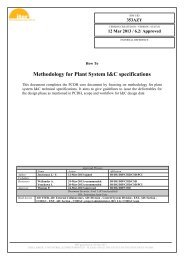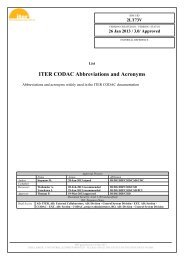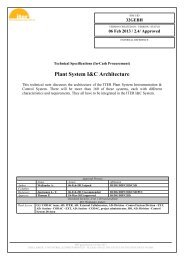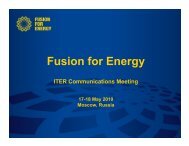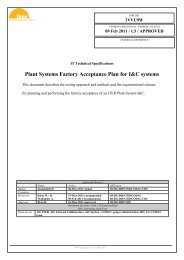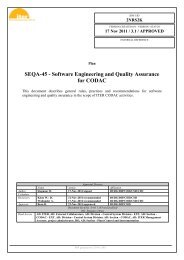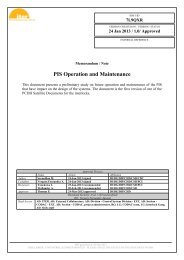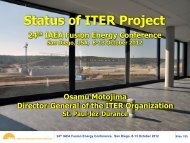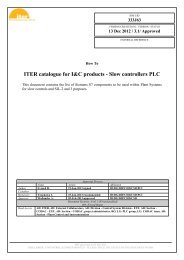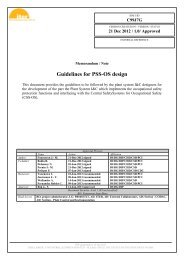Create successful ePaper yourself
Turn your PDF publications into a flip-book with our unique Google optimized e-Paper software.
How it works<br />
It’s simple – in principle, at least. Take two<br />
forms (isotopes) of hydrogen, squash them<br />
together, and you get a helium atom and a very<br />
energetic subatomic particle called a neutron.<br />
The product of the reaction is a fraction<br />
lighter than its atomic ingredients, and by<br />
Einstein’s famous equation E=mc 2 that tiny loss<br />
of mass results in a colossal release of energy.<br />
Harness that release in an efficient way and<br />
the world’s energy needs are solved.<br />
The problem is that the atomic ingredients<br />
of fusion, like all nuclei, repel each other. In the<br />
core of the sun, huge gravitational pressure<br />
allows fusion to take place at temperatures<br />
of around 15 million °C. In fusion machines,<br />
temperatures to achieve fusion need to be<br />
much higher – above 150 million °C.<br />
No materials on Earth could withstand direct<br />
contact with such temperatures. To achieve fusion,<br />
therefore, <strong>ITER</strong> will use a device called a tokamak,<br />
which holds the reacting plasma away from the<br />
furnace’s walls with intense magnetic fields.<br />
The aim is for <strong>ITER</strong> to generate 500 megawatts<br />
of fusion power. This would pave the way<br />
for a demonstration power plant, called DEMO,<br />
in which fusion power will produce steam<br />
and – by way of turbines – up to 1000 megawatts<br />
of net electrical power. That’s equivalent to a<br />
power plant that could supply about half a million<br />
British homes.<br />
Paris<br />
Marseille<br />
FuelLed by water<br />
and ingenuity<br />
The most efficient fusion reaction is that between two<br />
forms (isotopes) of hydrogen: deuterium and tritium.<br />
While deuterium can be extracted from seawater in<br />
virtually boundless quantities, the worldwide supply of<br />
tritium is limited, estimated at only 20 kilograms.<br />
Future fusion power plants will have to produce their<br />
own tritium. They will use “tritium breeding modules” made<br />
from lithium, which turns into tritium when bombarded by<br />
neutrons from the fusion reaction. Lithium is a light metal,<br />
as abundant as lead.<br />
<strong>ITER</strong> will test experimental tritium breeding modules.<br />
Environmental impact<br />
Iter<br />
The way to a benign and<br />
limitless new energy source<br />
Since the 1930s, thousands of scientists<br />
have been inspired by the sight of billions<br />
and billions of fusion furnaces – stars, like<br />
our own sun – that flare across the heavens,<br />
releasing vast amounts of light and energy.<br />
<strong>ITER</strong> is the latest experiment to tap<br />
fusion power, and its name means “the<br />
way” in Latin. The hope is that fusion could<br />
solve our energy needs by generating<br />
electricity from water, with no carbon<br />
dioxide emissions during operation and<br />
with relatively little nuclear waste.<br />
The terrific heat generated by fusion will be absorbed<br />
using 3 million cubic metres of water per year, about a fifth<br />
of the total transported by the local Verdon river.<br />
Tritium releases are predicted to be 100 times lower than<br />
the regulatory limit.<br />
Fusion reactions produce no long-lived waste. Low-level<br />
radioactive waste will result from the activation of some of<br />
the machine’s components. All waste materials will be<br />
treated, packaged and stored on site.<br />
In all, 39 protected or rare species will benefit from<br />
measures on the 180-hectare <strong>ITER</strong> site. Two areas have been<br />
fenced off to protect the Occitan cricket, two species of<br />
butterfly, woodlark nesting sites and rare orchids.<br />
Of the 2.5 million cubic metres of earth and rock moved to<br />
level the <strong>ITER</strong> platform, over two-thirds were reused on site.<br />
For news and ideas, see www.newscientist.com<br />
This poster was produced with the support of <strong>ITER</strong> Domestic Agencies:<br />
US <strong>ITER</strong>, <strong>ITER</strong> Korea, <strong>ITER</strong> India, the European Joint Undertaking,<br />
Fusion for Energy (Euratom) and the Fusion Research and Development<br />
Directorate, Japan Atomic Energy Agency.<br />
Edited by Roger Highfield, Valerie Jamieson, Neil Calder and Robert Arnoux<br />
Designed by Alison Lawn<br />
Graphics by Nigel Hawtin<br />
Picture research by Kirstin Jennnings<br />
deuterium<br />
tritium<br />
deuterium<br />
tritium<br />
1<br />
Puffs of deuterium and<br />
tritium gas are injected<br />
into the doughnutshaped<br />
vacuum vessel,<br />
called a tokamak. The<br />
gas weighs less than a<br />
postage stamp and<br />
fills a volume one-third<br />
that of an Olympic<br />
swimming pool.<br />
ash<br />
divertor<br />
6<br />
Fusion produces high-energy<br />
neutrons and helium particles<br />
that deposit their energy into<br />
the plasma and keep it hot,<br />
before becoming “ash”. The<br />
“ash” is eventually forced out<br />
through the divertor.<br />
voltage<br />
electromagnet<br />
current<br />
2<br />
Electricity flowing<br />
through this<br />
electromagnet<br />
produces a voltage<br />
across the gas.<br />
deuterium<br />
microwaves<br />
superconducting magnets<br />
plasma<br />
4<br />
Plasma is locked inside the<br />
vacuum vessel by magnetic<br />
fields that are created by an<br />
array of superconducting<br />
magnetic coils.<br />
Like the bar in an electric<br />
fire, the plasma quickly<br />
heats up to 10 million °C,<br />
but that’s not hot enough<br />
for fusion to occur.<br />
plasma<br />
200,000,000° C<br />
superconducting magnet<br />
-269°C<br />
7<br />
Neutrons and other particles<br />
bombard the tiles on the plasmafacing<br />
components and heat them.<br />
In a future power station this heat<br />
will be harnessed to make<br />
electricity. Superconducting<br />
magnets operate near absolute<br />
zero. The distance to the magnets<br />
from the heart of the plasma sees<br />
the greatest temperature gradient<br />
in the universe.<br />
deuterium<br />
nuclei<br />
tritium nuclei<br />
3<br />
Voltage rips electrons<br />
from the deuterium<br />
and tritium atoms.<br />
They turn into charged<br />
atoms (ions) within<br />
a few microseconds,<br />
forming a particle soup<br />
called a plasma.<br />
deuterium<br />
tritium<br />
fusion<br />
helium ash<br />
energetic neutron<br />
5<br />
To raise the temperature<br />
further, scientists fire radio<br />
and microwaves into the<br />
plasma and high-energy<br />
beams of deuterium atoms.<br />
The plasma then reaches<br />
100 - 200 million °C, hot<br />
enough for the deuterium<br />
and tritium nuclei to fuse.<br />
deuterium<br />
tritium<br />
frozen pellets 8<br />
of fusion fuel<br />
The plasma must be<br />
continuously refuelled with<br />
deuterium and tritium for the<br />
deuterium<br />
process to continue. Unburnt<br />
fuel is also recovered from<br />
the gaseous exhaust and the<br />
reaction is fine-tuned by firing<br />
frozen pellets of fusion fuel<br />
deep into the plasma.<br />
tritium<br />
electrons<br />
gaseous exhaust
PETER GINTER<br />
PLANET<br />
POWER<br />
Over half of the world’s population is represented in the <strong>ITER</strong> Organization.<br />
The <strong>ITER</strong> Organization was conceived as long ago as 1985 but was only<br />
formally established on 24 October 2007, following an agreement between the<br />
People’s Republic of China, the European Union, the Republic of India, Japan, the<br />
Republic of Korea, the Russian Federation and the United States of America.<br />
Conceptual design work began 20 years ago, in 1988. The final design for<br />
<strong>ITER</strong> was approved in 2001. The construction work on <strong>ITER</strong> is expected to be<br />
completed by around 2020. <strong>ITER</strong> is expected to work for around two decades.<br />
A technician in Forschungszentrum Karlsruhe,<br />
Germany, makes final checks of the prototype<br />
<strong>ITER</strong> cryogenic vacuum pumps<br />
Iter<br />
The way to a benign and<br />
limitless new energy source<br />
www.iter.org<br />
BRIEF HISTORY<br />
OF FUSION<br />
Some 70 years ago scientists obtained the first insights into the physics<br />
of sunshine: when the sun and other stars transmute matter, tirelessly<br />
transforming hydrogen into helium by the process of fusion, they release<br />
colossal amounts of energy.<br />
By the mid-1950s “fusion machines” were operating in the Soviet Union,<br />
the United Kingdom, the United States, France, Germany and Japan. Yet<br />
harnessing the energy of the stars was to prove a formidable task.<br />
After pioneering work in the Soviet Union in the late 1950s,<br />
a doughnut-shaped device called a tokamak was to become the<br />
dominant concept in fusion research. Since then, tokamaks have passed<br />
several milestones.<br />
Experiments with actual fusion fuel – a mix of the hydrogen<br />
isotopes deuterium and tritium – began in the early 1990s in the Tokamak<br />
Fusion Test Reactor (TFTR) in Princeton, US, and the Joint European Torus<br />
(JET) in Culham, UK.<br />
JET marked a key step in international collaboration, and in<br />
1991 achieved the world’s first controlled release of fusion power. While<br />
a significant amount of fusion power was produced by JET, and TFTR,<br />
exceptionally long-duration fusion was achieved in the Tore Supra<br />
tokamak, a EURATOM-CEA installation located at France’s Cadarache<br />
nuclear research centre and later in the TRIAM-1M tokamak in Japan and<br />
other fusion machines.<br />
In Japan, JT-60 has achieved the highest values of the three key<br />
parameters on which fusion depends – density, temperature and<br />
confinement time. Meanwhile, US fusion installations have reached<br />
temperatures of several hundred million °C.<br />
In JET, TFTR and JT-60 scientists have approached the long-sought<br />
“break-even point”, where a device releases as much energy as is required<br />
to produce fusion. <strong>ITER</strong>’s objective is to go much further and release<br />
10 times as much energy as it will use to initiate the fusion reaction. For<br />
50 MW of input power, <strong>ITER</strong> will generate 500 MW of output power.<br />
<strong>ITER</strong> will pave the way for the Demonstration power plant, or DEMO,<br />
in the 2030s. As research continues in other fusion installations worldwide,<br />
DEMO will put fusion power into the grid by the middle of this century. The<br />
last quarter of this century will see the dawn of the Age of Fusion.<br />
For news and ideas, see www.newscientist.com<br />
REX SCIENCE PHOTO LIBRARY<br />
The tokamak, a revolutionary magnetic<br />
confinement device, was developed in the late<br />
1950s at the Kurchatov Institute in Moscow<br />
Doctor Octopus in the film Spiderman 2<br />
HOW TO<br />
CATCH A STAR<br />
How can <strong>ITER</strong> handle matter 10 times as<br />
hot as the core of the sun By trapping it<br />
inside a strong magnetic field.<br />
Magnetic fusion machines of various<br />
shapes and arrangements were developed in<br />
several countries as early as 1950.<br />
But the breakthrough occurred in 1968 in<br />
the Soviet Union, when researchers were for<br />
the first time able to achieve remarkably high<br />
temperature levels and plasma confinement<br />
time – two key criteria for fusion. The secret<br />
of their success was a revolutionary<br />
doughnut-shaped magnetic confinement<br />
device called a tokamak, developed at the<br />
Kurchatov Institute, Moscow. From this time<br />
on, the tokamak became the dominant<br />
concept in fusion research.<br />
FICTIONAL<br />
FUSION<br />
Joint European Torus, UK<br />
Hollywood has paid an indirect tribute to how fusion power<br />
has the potential to transform our world by using the<br />
technology to spice up movie scripts.<br />
In Iron Man, the hero’s protective suit is powered by fusion.<br />
Before he turns bad, Spiderman 2’s Doctor Octopus creates<br />
a new power source using fusion.<br />
Chain Reaction, starring Keanu Reeves and Rachel Weisz,<br />
hinges on the invention of a rival fusion technology to that<br />
used by <strong>ITER</strong> (so-called bubble fusion).<br />
In The Saint, Val Kilmer attempts to steal a fusion formula<br />
from Elisabeth Shue. Once again, Hollywood scriptwriters<br />
have opted for a highly speculative alternative to <strong>ITER</strong>.<br />
The Mr. Fusion Home Energy Reactor was the name<br />
of a power source used by the DeLorean time machine that<br />
starred in the Back to the Future movie trilogy.<br />
Fusion reactors turn up in Star Trek too, for instance<br />
to power the impulse engines on Federation starships.<br />
JT-60, Japan<br />
ADITYA, India<br />
EAST, China<br />
T-15, Russia<br />
NSTX, Princeton, US<br />
KSTAR, Korea<br />
TOP<br />
TOKAMAKS<br />
<strong>ITER</strong> is the latest in a long succession of tokamak<br />
experiments, and is supported by advanced fusion research<br />
programmes around the world.<br />
Joint European Torus (JET) in Culham, United Kingdom<br />
(in operation since 1983)<br />
On 9 November 1991, JET achieved between 1.5 and 2 megawatts of fusion<br />
power – the first time a significant amount of power was obtained from<br />
controlled nuclear fusion. In 1997, JET established the current world record<br />
for fusion power of 16 MW for a limited duration and 5 MW for 5 seconds.<br />
JT-60 in Naka, Ibaraki prefecture, Japan (1985)<br />
In 1997, JT-60 set a world record for plasma temperature, density and confinement<br />
time.<br />
T-15 in Moscow, Russia (1988)<br />
T-15 is a Russian superconducting tokamak that operated until 1995. It is being<br />
upgraded to conduct fusion research to support the <strong>ITER</strong> and DEMO projects.<br />
ADITYA at the Institute for Plasma Research in Gujarat, India (1989)<br />
Aditya, India’s first tokamak, is a medium-sized device operated by the Institute for<br />
Plasma Research in Gandhinagar.<br />
NSTX in Princeton, <strong>New</strong> Jersey (1999)<br />
The National Spherical Torus Experiment (NSTX), at Princeton Plasma Physics<br />
Laboratory in the US, is a “spherical tokamak”.<br />
EAST (HT-7U) in Hefei, China (2006)<br />
Construction of the Chinese Experimental Advanced Superconducting Tokamak<br />
(EAST) took less than five years and was completed in March 2006.<br />
KSTAR in Daejon, South Korea (2008)<br />
The Korean tokamak KSTAR features magnets that are all superconducting,<br />
cooled to low temperatures so that they can produce stronger magnetic fields<br />
than ordinary electromagnets.



